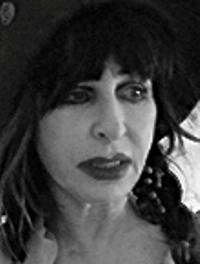 Colette Justine was born in Tunisia, she has a French nationality and a Jewish father – more is not known. Colette Justine better known as Colette and from 2001 on as Colette Lumiere is a multimedia artist ( painter , sculptress, installation maker ) known for her pioneering work in performance art, street art and her use of photography constructed photograph. She is also known for her work exploring male and female gender roles, different guises and personas and for her soft fabric environments where she often appears as the central element.
Colette Justine was born in Tunisia, she has a French nationality and a Jewish father – more is not known. Colette Justine better known as Colette and from 2001 on as Colette Lumiere is a multimedia artist ( painter , sculptress, installation maker ) known for her pioneering work in performance art, street art and her use of photography constructed photograph. She is also known for her work exploring male and female gender roles, different guises and personas and for her soft fabric environments where she often appears as the central element.
She was born in Tunis, Tunisia, of French nationality, and grew up in Nice, France before becoming a naturalized American citizen. She lives and works in New York City. Colette painted the streets during early morning hours not only to not be identified but also in also to avoid police arrest. In 1981, she joined Niki Carson’s La Rocka Modelling agency for unusual models, and staged a multimedia performance in his club Armegedon. By 1984, art in nightclubs was the vogue. The Palladium showcased not only her work but also those of Keith Herring, Jean-Michel Basquiat, Francesco Clemente and Julian Schnabel. In 1981 she broke record attendance in consecutive museums shows: her retrospective – “Colette – 10 Years of Work” at the Kunstverein Munster, “Other Realities” at the Museum of Contemporary Art in Houston Texas. Same year she joined Niki Carson’s La Rocka Modelling agency for unusual models, and staged a multimedia performance in his club Armegedon. By 1984, art in nightclubs was the vogue. The Palladium showcased not only her work but also those of Keith Herring, Jean-Michel Basquiat, Francesco Clemente and Julian Schnabel. On the West-Kunst show, 1981 in Cologne, she attracted attention for her spontaneous performance in bed with …Jürgen Klauke.
1991, her work was exhibited with Joseph Beuys, John Armedledder in the group show The Invisible Body, curated by Allan Jones at the Rempire Gallery in NYC. Once she re-established herself in New York (1992), she named her New York Downtown atelier The House of Olympia. The work of that decade was inspired by the eighteenth century. Colette begun using the name Lumiere publicly following the September 11 attacks after she was allowed to reenter her Lower Manhattan atelier, which had been covered with white dust from the nearby catastrophe.
Like the Russian punk band Pussy Riot, the New York performance artist Colette has ushered topless in a new feminism – only about thirty years earlier. In her ruffled Colette creations, under various names as Justine, Lumière, Marie-Antoinette, Mata-Hari, Lumiere, she acts absolutely self-consciously as an incarnation of the romantic feminine undogmatically. Colette presents herself as an artistic whole, indivuduell, as a wanderer – and quite museal. The living Colette, on the other hand, is a real nomad.
Even outside the museums, she always opened up new areas: shop windows, clubs, showrooms.
In art, Colette is still an avant-garde primordial rock. Whatever she did, she did it first. Probably without ever having heard of Colette, one of Hagn’s most prominent customers, the Scottish actress Tilda Swinton, also traced Colette’s traces of her sleepperformances in London, Rome and New York. Colette had already pre-arranged this in the seventies at the Berlin Academy of Arts on the Hanseatic Route, where she was sleeping naked in a grotto bathed in fluff-silk.
